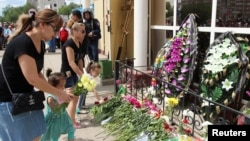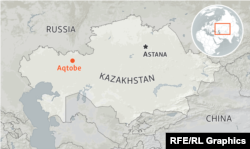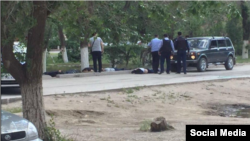
It was a Sunday, on the eve of Ramadan, when a group of mainly young men in the northwestern city of Aqtobe, Kazakhstan, robbed two gun shops and set off to attack a military facility. Eventually, 25 people would be dead and dozens wounded, making it the deadliest day in Kazakhstan’s nearly 25-year history.
Three days passed before Kazakh President Nursultan Nazarbaev spoke to the nation about the June 5 violence in Aqtobe. But rather than comfort the nation, his words were of enemies, plots hatched outside the country, color revolutions, and the need to “destroy” the suspects still at large if they offered any resistance.
The names and photographs of the suspects were published in Kazakhstan media (although at least one picture was of someone not involved in the violence), but it remains unclear what the connection was between this group of at least 28 suspects and what motivated them to allegedly commit this violence.
To take a closer look at what happened, the government’s handling of the situation, and what the possible cause of this violence might be, RFE/RL’s Turkmen Service, known locally as Azatlyk, assembled a majlis, a panel.
Azatlyk Director Muhammad Tahir moderated the panel. Joining from Astana was Aigerim Toleukhanova (@aygeryma), a correspondent for The Conway Bulletin. The Almaty-based correspondent for bne IntelliNews, Naubet Bisenov, also participated. And since I had just written a report about western Kazakhstan, I made some comments, too.
The violence in Aqtobe came some two weeks after Kazakhstan saw the biggest protest in the country’s history. That protest happened despite repeated warnings from officials and preemptive detentions of dozens of people who were calling for demonstrations on May 21. The protests over the government’s land-privatization plans initially started spontaneously in late April in major cities throughout Kazakhstan.
So the country was already on edge when the shooting started in Aqtobe, a city of some 400,000 people located about 100 kilometers south of the border with Russia.
Bisenov started the majlis, saying, “Despite authorities branding them as terrorists, we don’t know who these people are and what their goals were.” He continued: “Looking at their pictures and the little information [from] their biographies, it could be any person living in Aqtobe, or in Atyrau, or in Almaty.”
Toleukhanova agreed the picture was still very unclear, but she said the choice of target might say something about the motives of the attackers.
“Even though they didn’t say anything, they showed with their actions. They attacked...official places, like military buildings, [so] they’re kind of attacking the government,” Toleukhanova said.
The government has not provided much information. Authorities have delivered a rough sequence of events in Aqtobe on June 5, given casualty figures, warned that six suspects are still at large (five of whom were killed in a June 10 security operation), and announced the country would be on a heightened state of alert for 40 days.
Toleukhanova said she had spoken with people in Aqtobe. “People are still going to work and doing their usual things, [but] they’re still very afraid because they heard all the shooting right in front of their homes, and in parks, and they think this may happen again.”
And on June 7, authorities offered conflicting information about an alleged shooting at an Aqtobe kindergarten and children’s summer camp. Toleukhanova explained: “Our security service confirms one attack while the Ministry of Internal Affairs denies that this has happened, so people here are really getting confused about what’s going on in Aqtobe.”
Nazarbaev was shown on national television on June 7 receiving the apparently erroneous report about the shooting at the kindergarten from the National Security Committee.
The Kazakh president later addressed the nation, speaking about “terrorists” and “extremists,” radical sects (presumably Islamic), about the different guises “colored revolutions” can assume, including in the form of protests, and how they can lead to rash attempts to overthrow the government.
“Nazarbaev, after days of silence, tried to address people on the issue," Bisenov said. "But as the president of the country, he didn’t offer solutions to the problems."
Toleukhanova said Nazarbaev’s reference to foreign influence in the Aqtobe violence, rather than domestic causes, has become a standard response from the authorities amid the recent problems.
“Claims that it’s outside forces that are responsible for these attacks are also kind of showing us that the government denies that anything is wrong inside the country," Toleukhanova said. "It’s everything from outside.”
As for the cause of this recent unrest, Bisenov said, “The origins of such events is a huge poor-rich divide and the gap that has emerged between ordinary people and the authorities, which of course has been exacerbated by the ongoing economic crisis...”
Toleukhanova agreed, saying, “It’s mostly about social and economic problems.”
Aqtobe, and western Kazakhstan in general, is home to the country's oil and gas fields. Kazakhstan grew rich from this oil and gas, but most of the money goes east, to the capital, Astana, and the commercial capital, Almaty. Billions of dollars have been poured into building up Astana, once a modest city called Tselinograd during Soviet times. After the capital was transferred at the end of 1997 from Almaty to Astana (then called Aqmola), Kazakhstan’s government embarked on a huge program to raise a modern capital, filled with architectural wonders and excess, such as the city's giant aquarium.
By contrast, Bisenov said, “If you go to western Kazakhstan, you will see bad roads, lack of water supplies, a lot of social problems, and the cost of living in these regions is very high because of geography and because of climate.”
And during the current economic downturn, Bisenov added, the people of western Kazakhstan are “also the ones who are suffering the consequences of the problems in the oil industry, such as layoffs of workers, and it is the local population in these regions which have put up with the damage the oil and gas industry inflicts on the regional environment and on the health of the local population.”
Apparently, Kazakh authorities are themselves at a loss as to what led this group of people to take such measures, but the government’s attempts at crisis management have already revealed some severe deficiencies in communication between government agencies and ministries and between the government and Kazakhstan’s people.
The panel explored all of these topics in greater detail and looked at other factors that might have contributed to the violence in Aqtobe and the rift that is widening between the authorities and the people.
Listen to or download the Majlis podcast above or subscribe to Majlis on iTunes.









